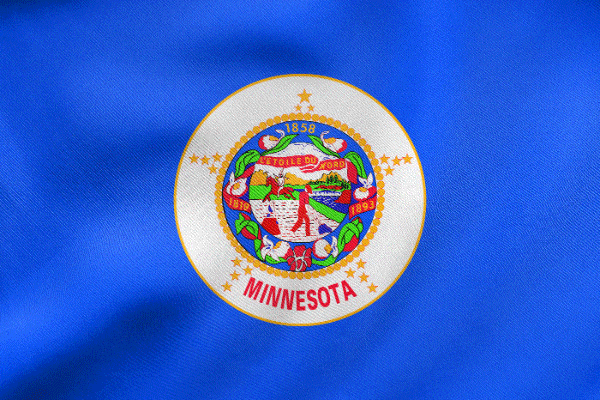Minnesota
State abbreviation/Postal code: Minn./MN Governor: Mark Dayton, D (to Jan. 2019) Lieut. Governor: Tina Smith, D (to Jan. 2019) Senators: Amy Klobuchar, D (to Jan. 2019); Al Franken, D (to Jan. 2021) Historical biographies of Congressional members Secy. of State: Steve Simon, D (to Jan. 2019) Atty. General: Lori Swanson, D (to Jan. 2019) State Auditor: Rebecca Otto, D (to Jan. 2019) Organized as territory: March 3, 1849 Entered Union (rank): May 11, 1858 (32) Present constitution adopted: 1858 Motto: L'Étoile du Nord (The North Star)
Nicknames: North Star State; Gopher State; Land of 10,000 Lakes Origin of name: From a Dakota Indian word meaning “sky-tinted water” 10 largest cities (2012): Minneapolis, 392,880; St. Paul, 290,770; Rochester, 108,992; Duluth, 86,211; Bloomington, 86,033 Brooklyn Park, 77,752; Plymouth, 72,928; St. Cloud, 65,986; Eagan, 64,854; Woodbury, 64,496 Land area: 79,610 sq mi. (206,190 sq km) Geographic center: In Crow Wing Co., 10 mi. SW of Brainerd Number of counties: 87 Largest county by population and area: Hennepin, 1,152,425 (2010); St. Louis, 6,226 sq mi. State forests: 58 (nearly 4 million ac.) State parks: 72 Residents: Minnesotan 2015 resident population est: 5,489,594 2010 resident census population (rank): 5,303,925 (21). Male: 2,632,132; Female: 2,671,793. White: 4,524,062 (88.0%); Black: 274,412 (4.4%); American Indian: 60,916 (1.0%); Asian: 214,234 (3.5%); Other race: 103,000 (1.4%); Two or more races: 125,145 (1.8%); Hispanic/Latino: 250,258 (4.0%). 2010 population 18 and over: 4,019,862; 65 and over: 683,121; median age: 37.3. |
Following the visits of several French explorers, fur traders, and missionaries, including Jacques Marquette, Louis Joliet, and Robert Cavelier, Sieur de la Salle, the region was claimed for Louis XIV by Daniel Greysolon, Sieur Duluth, in 1679.
The U.S. acquired eastern Minnesota from Great Britain after the Revolutionary War and 20 years later bought the western part from France in the Louisiana Purchase of 1803. Much of the region was explored by U.S. Army lieutenant Zebulon M. Pike before the northern strip of Minnesota bordering Canada was ceded by Britain in 1818.
The state is rich in natural resources. A few square miles of land in the north in the Mesabi, Cuyuna, and Vermilion ranges produce more than 75% of the nation's iron ore. The state's farms rank high in yields of corn, wheat, rye, alfalfa, and sugar beets. Other leading farm products include butter, eggs, milk, potatoes, green peas, barley, soybeans, oats, and livestock.
Minnesota's factories produce nonelectrical machinery, fabricated metals, flour-mill products, plastics, electronic computers, scientific instruments, and processed foods. The state is also a leader in the printing and paper-products industries.
Minneapolis is the trade center of the Midwest, and the headquarters of the world's largest super-computer and grain distributor. St. Paul is the nation's biggest publisher of calendars and law books. These “twin cities” are the nation's third-largest trucking center. Duluth has the nation's largest inland harbor and now handles a significant amount of foreign trade. Rochester is home to the Mayo Clinic, a world-famous medical center.
Tourism is a major revenue producer in Minnesota, with arts, fishing, hunting, water sports, and winter sports bringing in millions of visitors each year.
Among the most popular attractions are the St. Paul Winter Carnival; the Tyrone Guthrie Theatre, the Institute of Arts, Walker Art Center, and Minnehaha Park, in Minneapolis; Boundary Waters Canoe Area; Voyageurs National Park; North Shore Drive; the Minnesota Zoological Gardens; and the state's more than 10,000 lakes.
See more on Minnesota:
Encyclopedia: Minnesota
Encyclopedia: Geography
Encyclopedia: Economy
Encyclopedia: Government
Encyclopedia: History
Monthly Temperature Extremes
All U.S. States: Geography & Climate
Printable Outline Maps
Record Highest Temperatures
Record Lowest Temperatures
Highest, Lowest, and Mean Elevations
Land and Water Area
All U.S. States: Population & Economy
Historical Population Statistics, 1790–Present
Per Capita Personal Income
Minimum Wage Rates
State Taxes
Federal Government Expenditure
Percent of People in Poverty
Births and Birth Rates
Homeownership
Percentage of Uninsured by State
All U.S. States: Society & Culture:
Most Livable States
Healthiest States
Most Dangerous States
Smartest States
Crime Index
Residency Requirements for Voting
Compulsory School Attendance Laws
Driving Laws
National Public Radio Stations
Selected famous natives and residents:
- LaVerne, Maxene, and Patti Andrews singers;
- Warren E. Burger jurist;
- William E. Colby CIA director;
- William Demarest actor;
- William O. Douglas jurist;
- Bob Dylan singer and composer;
- F. Scott Fitzgerald novelist;
- Judy Garland singer and actress;
- J. Paul Getty oil executive;
- Cass Gilbert architect;
- Duane Hanson sculptor;
- Hubert H. Humphrey senator and vice president;
- Jessica Lange actress;
- Sinclair Lewis novelist;
- Cornell MacNeil baritone;
- Roger Maris baseball player;
- E. G. Marshall actor;
- Charles H. Mayo surgeon;
- William J. Mayo surgeon;
- Eugene J. McCarthy former senator;
- Kate Millett feminist;
- Walter F. Mondale former vice president;
- Gen. Lauris Norstad NATO commander;
- Westbrook Pegler columnist;
- John Sargent Pillsbury businessman;
- Prince musician;
- Marion Ross actress;
- Jane Russell actress;
- Harrison E. Salisbury journalist;
- Charles M. Schulz cartoonist;
- Max Shulman novelist;
- Maurice H. Stans secretary of commerce;
- Harold E. Stassen government official;
- Michael Todd producer;
- Frederick Weyerhaeuser businessman;
- Gig Young actor.


